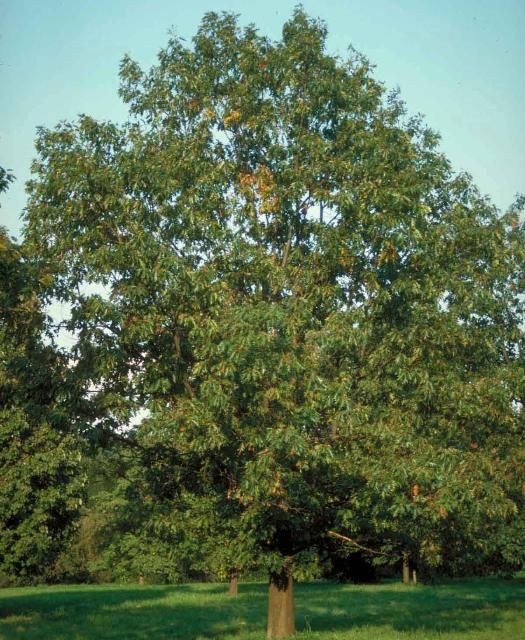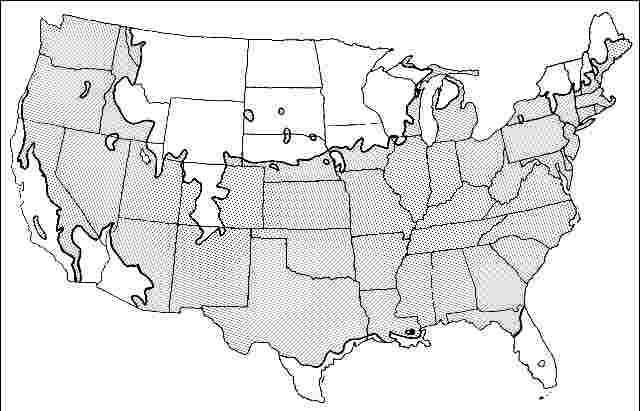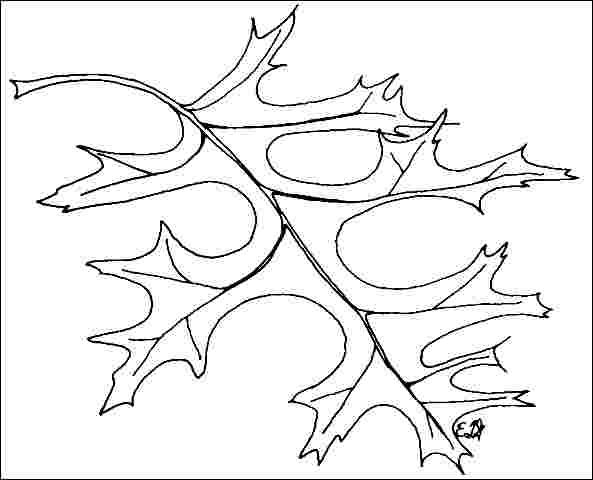Introduction
Able to reach a height of 75 feet and a spread of 45 to 60 feet, scarlet oak is so-named for its beautiful, red-colored fall leaves. Fairly smooth grey bark in youth roughens to a dark brown or black on the trunk of older specimens which can be four feet in diameter. Leaves are more deeply lobed than Quercus rubra but otherwise the trees look very much alike. The crown should be built like many other oaks with a central trunk and lateral branches well spaced at 2 or 3 foot intervals. The rounded, spreading canopy makes the tree well-suited for planting along streets. The trunk flares out at the base lifting sidewalks and curbing if planted in tree lawns less than eight feet wide.

Credit: Ed Gilman, UF/IFAS
General Information
Scientific name: Quercus coccinea
Pronunciation: KWERK-us kock-SIN-ee-uh
Common name(s): Scarlet oak
Family: Fagaceae
USDA hardiness zones: 5A through 8B (Fig. 2)
Origin: native to North America
Invasive potential: little invasive potential
Uses: street without sidewalk; shade; parking lot island > 200 sq ft; tree lawn > 6 ft wide; highway median
Availability: not native to North America

Description
Height: 60 to 75 feet
Spread: 45 to 60 feet
Crown uniformity: symmetrical
Crown shape: round
Crown density: moderate
Growth rate: moderate
Texture: medium
Foliage
Leaf arrangement: alternate (Fig. 3)
Leaf type: simple
Leaf margin: lobed, parted
Leaf shape: ovate, oblong, elliptic (oval)
Leaf venation: pinnate, reticulate
Leaf type and persistence: deciduous
Leaf blade length: 2 to 4 inches, 4 to 8 inches
Leaf color: green
Fall color: red
Fall characteristic: showy

Flower
Flower color: brown
Flower characteristics: not showy
Fruit
Fruit shape: round, oval
Fruit length: .5 to 1 inch
Fruit covering: dry or hard
Fruit color: brown
Fruit characteristics: attracts squirrels/mammals; not showy; fruit/leaves a litter problem
Trunk and Branches
Trunk/bark/branches: branches don't droop; not showy; typically one trunk; thorns
Pruning requirement: little required
Breakage: resistant
Current year twig color: reddish, brown
Current year twig thickness: medium
Wood specific gravity: 0.67
Culture
Light requirement: full sun
Soil tolerances: clay; sand; loam; acidic; well-drained
Drought tolerance: moderate
Aerosol salt tolerance: moderate
Other
Roots: not a problem
Winter interest: no
Outstanding tree: no
Ozone sensitivity: sensitive
Verticillium wilt susceptibility: resistant
Pest resistance: resistant to pests/diseases
Use and Management
Does well as a street tree given plenty of soil space to develop. Plant on 30- to 40-foot-centers to form a canopy overhead in residential neighborhoods. It is not for restricted soil spaces such as downtown planting pits, although it appears tolerant of soil compaction.
This oak will grow on sandy soils and is reported to exhibit less chlorosis problems than pin oak but should still be grown on acidic soils. Appears to adapt to compacted clay soil. Scarlet oak has a tap root on loose, well-drained soil and is difficult to transplant; only use nursery grown plants for transplanting, not those collected from the wild.
Propagation of oaks by seed is the most common, but horticulturists are developing techniques for vegetative propagation.
Pests
This tree usually has no serious pests.
Galls cause homeowners much concern. There are many types and galls can be on the leaves or twigs. Most galls are harmless so chemical controls are not suggested.
Scales of several types can usually be controlled with sprays of horticultural oil.
Aphids cause distorted growth and deposits of honeydew on lower leaves. On large trees, naturally-occurring predatory insects will often bring the aphid population under control.
Boring insects are most likely to attack weakened or stressed trees. Newly planted young trees may also be attacked. Keep trees as healthy as possible with regular fertilization and water during dry weather.
Many caterpillars feed on oak. Large trees tolerate some feeding injury without harm. Trees repeatedly attacked, or having some other problem, may need spraying. Tent caterpillars form nests in trees then eat the foliage. The nests can be pruned out when small. Where they occur, gypsy moth caterpillars are extremely destructive on oaks. Fall cankerworm has been a problem in some years.
Twig pruner causes twigs to drop off in the summer. The larvae ride the twig to the ground. Rake up and destroy fallen twigs.
Lace bugs suck juices from leaves causing them to look dusty or whitish gray but infestation is usually not serious.
Leaf miners cause brown areas in leaves. To identify leaf miner injury tear the leaf in two across the injury. If the injury is due to leaf miner, upper and lower leaf surfaces are separate and black insect excrement will be seen.
Diseases
Except for oak wilt, the tree has few serious diseases.
Anthracnose may be a serious problem in wet weather. Infected leaves have dead areas following the midrib or larger veins. These light brown blotches may run together and, in severe cases, cause leaf drop. Trees of low vigor, repeatedly defoliated, may die. Trees defoliated several years in a row may need spraying, to allow the tree to recover.
Canker diseases attack the trunk and branches. Keep trees healthy by regular fertilization. Prune out diseased or dead branches. The chestnut blight fungus can cause cankers at the base of the trunk.
Leaf blister symptoms are round raised areas on the upper leaf surfaces causing depressions of the same shape and size on lower leaf surfaces. Infected areas are yellowish-white to yellowish-brown. The disease is most serious in wet seasons in the spring but it does not need to be treated.
A large number of fungi cause leaf spots but are usually not serious. Rake up and dispose of infected leaves, if you wish.
Powdery mildew coats leaves with white powdery growth.
Shoestring root rot attacks the roots and once inside moves upward, killing the cambium. The leaves on infected trees are small, pale or yellowed and fall early. There is no practical control. Healthy trees may be more resistant than trees of low vigor.
Chlorosis due to iron-deficiency occurs on high pH soil.